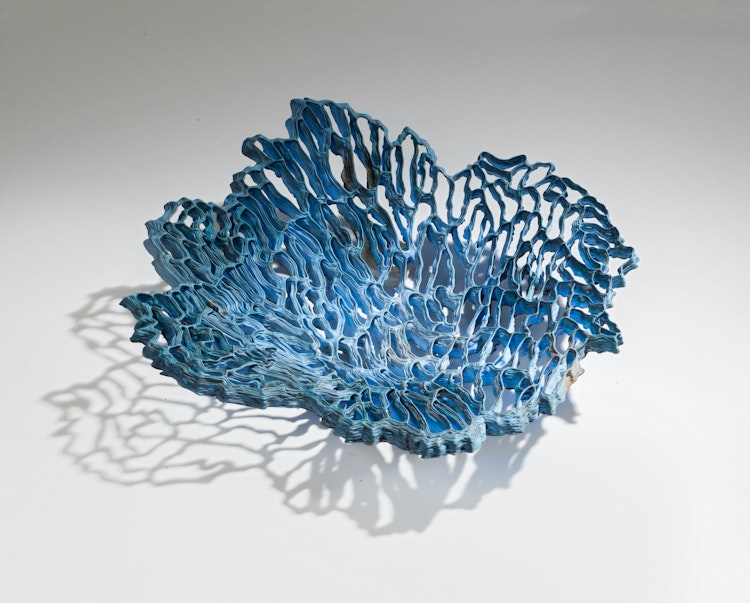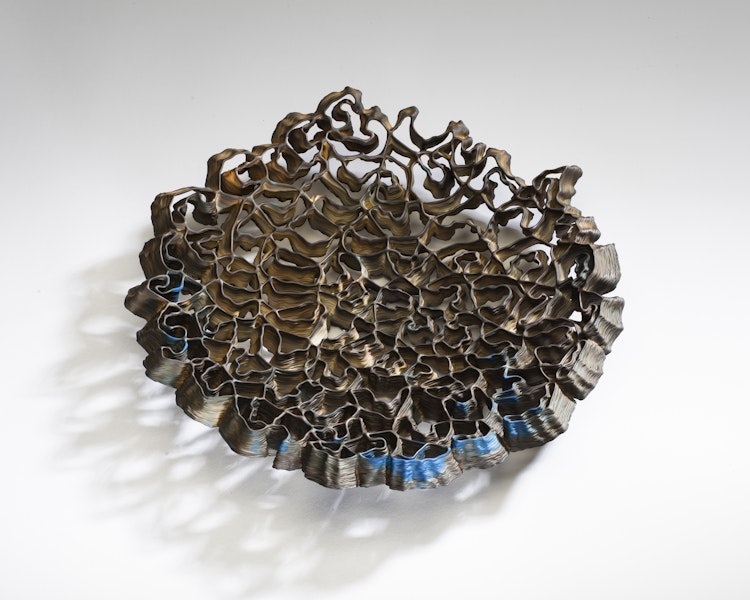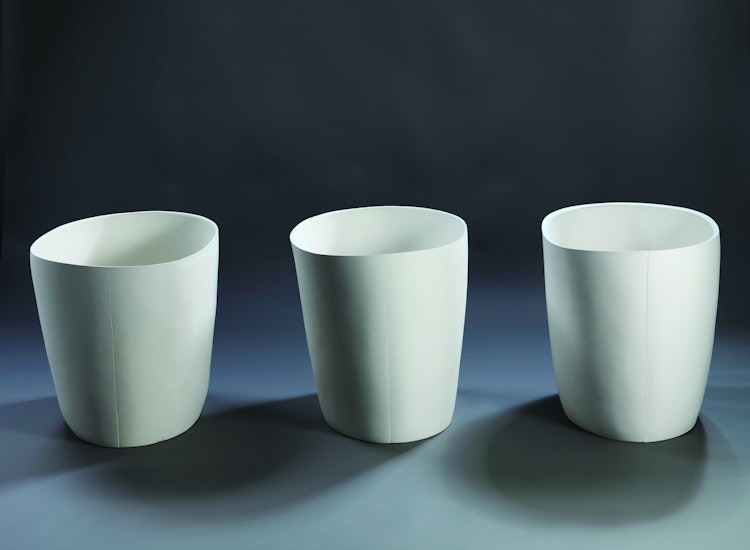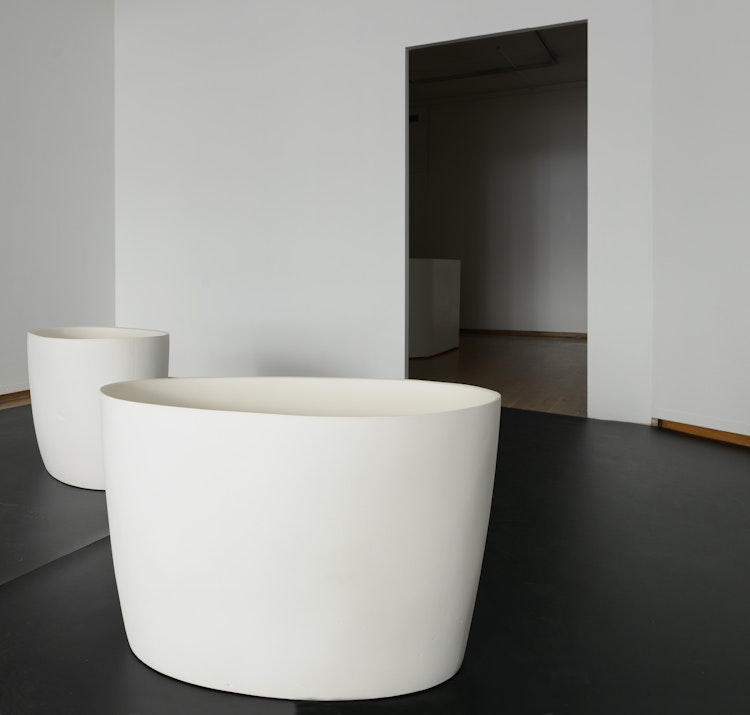

Lars Elton
Size becomes a fascinating issue when studying the ceramics of Sidsel Hanum. This Norwegian ceramicist makes objects with intricate patterns of minute size, to vessels so big, you can take a bath in them! But even if huge sizes impress, it is her small objects that attract international attention.
In November 2012, Sidsel Hanum (b. 1955) will make her debut at SOFA Chicago. Her first exhibit in the USA since 2000 is the result of many years of research, innovation, and hard work. For three years in a row, she has attracted interest at Collect in London, ‘the premier annual fair in Europe for international contemporary craft of museum quality’. Hanum has exhibited twice (2006 and 2011) at Flow Gallery in London, and has been a frequent exhibitor at galleries and museums in Norway and abroad. It is clear, then, that her career has yet to reach its peak.
Two years ago, Hanum won the Craft Award 2010, the most prestigious national prize for Norwegian contemporary craft. It came with a cheque for NOK 100,000 and put her in the company of the best names in Norwegian contemporary craft.1
Tidewater
Another mark of distinction is the fact that she was the first Norwegian ceramicist to hold a major solo exhibition in a museum that does not specialise in arts and crafts. Norway has three particularly craft-oriented museums, in Oslo, Bergen, and Trondheim, but in 2010 Hanum was invited to exhibit at Lillehammer Art Museum.2
To put it simply, most Norwegian art museums do not pay much attention to craft-based art. Accordingly, it created a small sensation when Hanum was invited to exhibit in one of the most prominent art museums in Norway. Lillehammer Art Museum is housed in a beautiful building designed in 1994 by the celebrated architectural firm Snøhetta (which is incidentally now involved in the last stages of completing its part of the Ground Zero Memorial and Museum in New York).

Hanum’s solo show in Lillehammer was opened in February 2010 by Jonas Gahr Støre, Norway’s Minister of Foreign Affairs. Its title was Tidevann (Tidewater), an allusion to nature as a source of inspiration. The title could, however, also be interpreted as an expression of the tremendous breadth in Hanum’s production. This is clearly seen when noting the contrast between the objects that attract international attention at fairs such as Collect, and the work for which she won the Craft Award 2010. The works presented at international fairs are modest in size and consist of many small elements. The award-winning work, by contrast, is big enough to take a bath in.
Layers of liquid porcelain
Even though it was a retrospective show, the Lillehammer exhibition was the first chance to see Hanum’s coral-inspired objects on a broad scale. We had seen some hints earlier, but this show reflected a shift in her career. She explains:
‘I have an “ordinary” history as a ceramicist of making containers and objects from known shapes. The shift came around 2002/3, when I started to work with liquid porcelain. I construct these objects with an old technique that in Norwegian is called “horning”. It’s normally used to apply porcelain décor to surfaces. The liquid porcelain is contained in a plastic bottle and poured out through a hole in a pointed spout. What got me started was inspiration from a dinner party, where the host had decorated the table with pumpkins. I found the forms beautiful and thought I could use them. I made a cast of half of a pumpkin, and it reminded me of potato buckets from my childhood. Inside this form, I started to “draw” with the porcelain, applying it in thin stripes, one on top of the other, to create a new and fragile object. The first objects I made, for instance Gul strek (Yellow Line, 2006), had only three or four layers. Now I might sit for hours and days building intricate forms with up to 50 layers.’
Photos courtesy of Sidsel Hanum.
Here I must add that Sidsel Hanum grew up in Hamar, an inland city on the lake Mjøsa, situated amongst vast forests and farming communities. Taking part in the autumn activity of harvesting potatoes was something most children did when she was young. The potato buckets were made of braided ropes that had an expression similar to that of Gul strek. She still thinks the buckets are beautiful. Today Hanum lives and works on the small island of Borøy near Tvedestrand, southern Norway, in a house but a few metres from the seashore. This shift in environment has inspired her to seek new goals:
‘I find great inspiration in sea coral. Pieces of it are always lying on my work desk and I enjoy studying them at all times. This doesn’t mean I try to copy them, but I build my objects on the fascinating idea that it’s possible to build a form and an object out of next to nothing. The porcelain “thread” is no more than one millimetre thick,’ she explains.
In addition to intricacy, the coral-inspired forms have yet another fascinating aspect: beautiful colours. These are made with highly toxic metal chlorides. But the disadvantages are compensated for by the fact that they do not, like glazing, occlude the tiny details. The chlorides reveal every trace in the clay, and the colours (she cannot totally control them) add a freshness and glow that make it possible to see all the surface details.

Great knowledge and sense of form
But then, having studied her tiny details – is it really true that there are huge shifts and contrasts in her oeuvre? Well, not in Sidsel Hanum’s own eyes. When I met her to talk about her work, she denied the claim, mildly but firmly. Her protest incites me to examine the large objects more closely.
In 2010, some professionals working in the field of craft held that Sidsel Hanum was long overdue for receiving the Craft Award 2010. The prize was given for three large vessels in bright white porcelain, each measuring no less than 55×83×50 cm. As stated, they are big enough to take a bath in, but that would of course be difficult since they are unglazed. Reflecting on Hanum’s works, the jury said: ‘(…) contemplation rather than use is what one thinks about when looking at these three works, individually or as a group’. In other words, in spite of having shapes inspired by well-known vessel forms, they were not intended for use.
The jury also stated why it had given Hanum the award: ‘The surfaces are smooth, white, and unglazed. Hanum has built her ovals upward, demonstrating superlative mastery of the fragile porcelain material. The technical execution contributes to the expression; here a naked, elegant silence emerges. Oval no. 5, Oval no. 6 and Oval no. 8 convince us with their tight and self-assured execution. They are beautiful in their reserved nature. There is no unnecessary information. The works reveal an artist who possesses great knowledge and a sure sense of form, and who therefore dares [to create] a simple expression.’
Can one put it better? When it comes to being daring, Sidsel Hanum has a long history. In this context, however, the claim of ‘huge shifts and contrasts’ might seem to be contradicted, since simple expressions have been the hallmark of her work ever since she was a student.
But one milestone in her development was surely her first solo exhibition in Norway, at Bomuldsfabriken Kunsthall in 1997. This regional museum in Arendal, a town on Norway’s south coast, gave Hanum the opportunity to display 52 oval vessels, more or less identical in shape but highly individual in detail.

‘I build my objects on the fascinating idea that it’s possible to build a form and an object out of next to nothing.’


Meticulous surface treatment
What was daring about these works was their surface treatment. The oval containers were pinched, scraped, holed, punched, and ‘molested’ in different ways. They seemed to suggest that their maker was someone far different from my impression of Sidsel Hanum; the expression was of a self-harmer, someone who abuses his or her own body in an effort to deal with psychic pain. This gruesome metaphor was expressed through a series of beautiful shapes with subdued colour treatment. The installation – 52 oval containers placed on simple steel shelves – was a muffled scream for ceramic power and control. At least, in this writer’s eyes.
‘That was an important exhibition for me,’ says Hanum. ‘It was the result of a slowly rolling journey, a caravan that leads you forward. The method gave me a chance to discover who I was. That’s why I called the installation Caravan. Being given the possibility to do that journey was one of the best things that had happened to me up to that point. I held two other solo exhibitions the same year, but the one at Bomuldsfabriken was the first time I had the opportunity to work on one project for such a long time. Having that perspective gave me the chance to concentrate on developing something new and to work it through down to the smallest detail,’ Hanum recalls.
‘A nice experience related to this is the fact that time is something that comes to you,’ Hanum explains.
Making her objects takes a lot of time, yet she finds the process meditative. She says it moves her mind, and that the objects grow on their own accord. Nevertheless, the objects do not have a soul. That’s why she gives them names that remind her of the situation, time, or place where they were made. The small organic shapes are thus related to a human experience – just as are the huge ovals built with the same technique in another format. So the shift in size is probably not as huge as I, the writer, anticipated.


